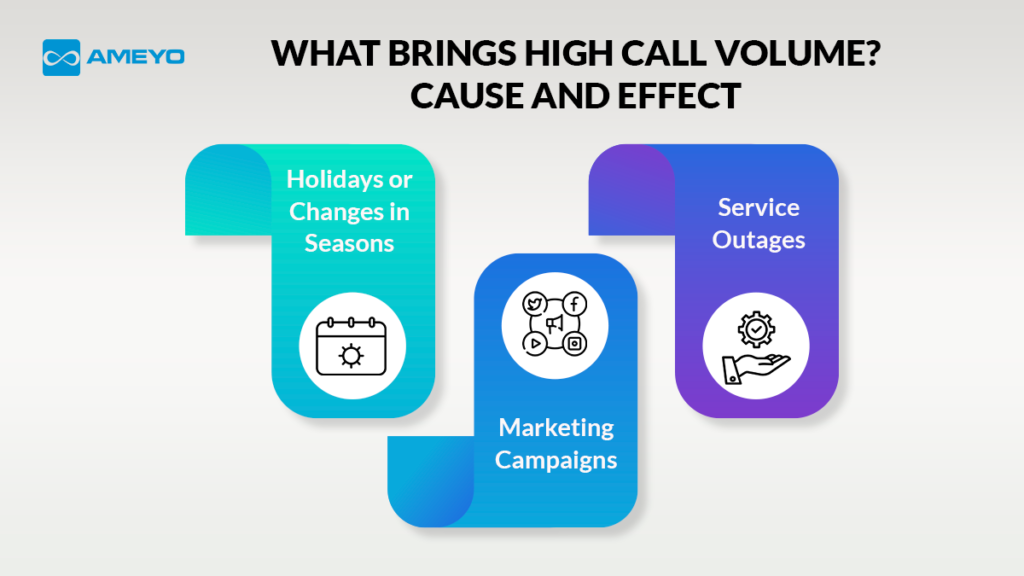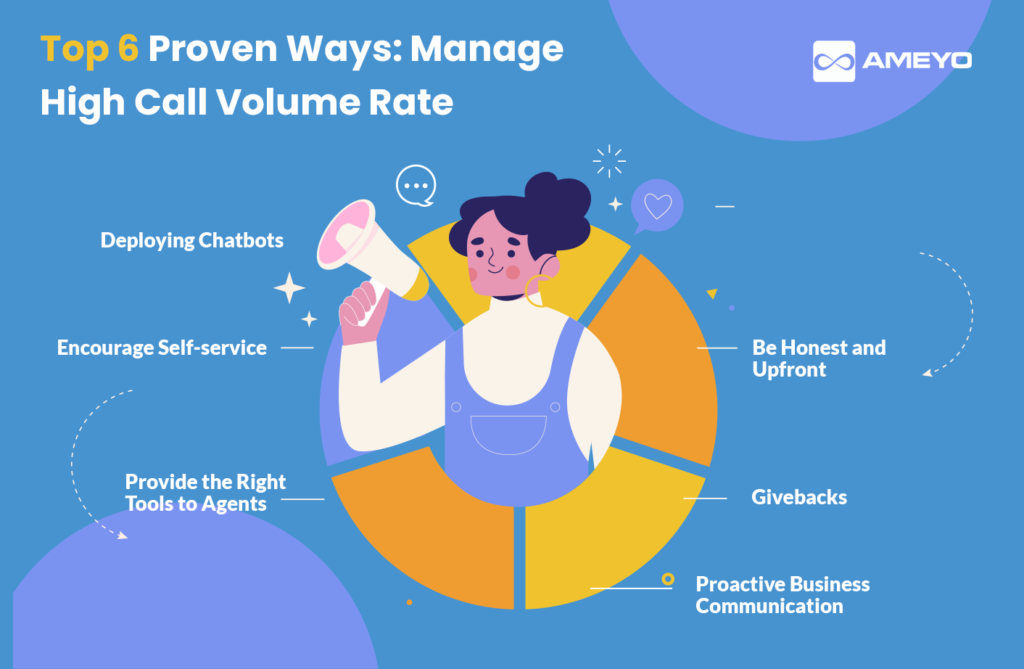How do you manage high call volume at your call center? Do you have any strategies in place, or is it just simple fire-fighting that your team does and leaves much damage behind, like dissatisfied customers?
A situation like this is not favorable for your business’s health. Customers waiting in long call queues, being addressed with below-par support from the call support team, and your support team being exhausted and strained are some of the primary effects of a poorly managed high call volume situation. The secondary and the more permanent effects would be tarnished consumer experience score and your customers moving on to buy from your competitors and leaving a negative word for you in the market.
In case you are wondering how robust call center solutions help your business to retain customers, then the following numbers will give you a clear picture. To win and retain these sorts of loyal customers, a company should take extraordinary measures to maintain a great customer experience.
What is High Call Volume at a Call Center?
Whenever there is a hike in call volumes, the work output for call centers is bound to increase. The industry standard for high call volume is 10 percent higher than normal volume. However, any challenging number for your contact center can also be termed a high call volume bar for internal clarity. The 10 percent figure can also vary depending upon the operating industry of the business, company size, customer base, etc.
Cause and Effect: What Brings High-call Volume?
High call volumes are events that are specific to a few events and scenarios. Some of these situations are mentioned below:

1. Holidays or Changes in Seasons
These are purely time-specific events, and companies can prepare themselves well in advance for these moments. Pest control or pool cleaning businesses will experience a surge in customer calls during the warmer seasons. Another example is restaurants and food delivery apps, as they deal with higher call volumes during weekends and even higher during a holiday.
2. Marketing Campaigns
A business can expect a significant surge in calls during or post a marketing campaign. Many people can get intrigued by new products or valuable offers mentioned in the marketing drive and will possibly reach out to the business for more details. Even though it is a good sign, these extra calls need to be addressed properly to reap the maximum benefit from the marketing efforts.
3. Service Outages
While service outages cannot be predicted (except maintenance), companies can still keep themselves ready for some level of spiking in call volumes. The service outage is one event that sends the call centers into overdrive, with many customers asking about the disruption or unavailability of service.
Top 6 Proven Ways: Manage High Call Volume Rate
Forecasting a surge in call volume can give an idea to the business about the upcoming challenge. But, just the availability of data can’t help in efficiently managing such situations. Appropriate tools and strategies are required to make the best use of the forecast and navigate successfully through a high-call volume event.
The following six methods are some of the best call center solutions to manage calls during surge events:

1. Deploying Chatbots and Encouraging Customers to Use Them
Most customer queries during a surge are basic. They don’t necessarily require an agent to solve the issue. Using a chatbot, many customer queries can be solved, bringing the call volume to a lower level.
Chat support handled by live agents may not be as cutting edge as modern-day AI chatbots, but they efficiently serve the purpose. A self-service content base can provide customers with the necessary answer without the support agent getting actively involved in it. Hence, freeing up much time to solve complex queries.
2. Encourage Self-service
More often than not, the issues faced by customers are not very unique from each other. Managing the same type of queries over and over can also negatively affect the support agent by making the job overtly monotonous, especially during high volumes. A super effective call center solution to avoid this is to encourage customers to go for self-service content mentioned in FAQs in the app’s or website’s helpdesk.
The support staff usually writes this content as they are well-versed in all the challenges that customers face during various event-specific call surges. This content can be detailed articles, brief FAQs, or even video content. The decision should be yours while choosing the form of content as you would know what will best serve your customers.
3. Provide the Right Tools to your Agents
When your support team is equipped with capable tools, dealing with high call volumes will become significantly easier. An omnichannel ticketing system can go miles while helping an agent manage a higher number of calls with a much better customer satisfaction rate. Some of the many features and benefits of these tools are mentioned below:
- Canned responses can close basic queries way faster.
- Third-party CRM tools can give an in-depth insight into a customer’s conversational history with the business.
- Allow customers to leave swift feedback.
- Access to customers across various communication channels like social media, website tickets, etc. through a single dashboard
4. Be Honest and Upfront
Customers loyal to a brand will always appreciate transparency and honesty. Despite applying proven strategies, a business may face a situation where they cant effectively handle the high-call volume. In such a scenario, being transparent about the situation, communicating the expected wait time, and pointing toward other possible solutions will be well received by the customers.
5. Givebacks
No customer likes to be put on hold and wait in long call queues. If the waiting queue is long, your call abandonment rate will shoot up. That is not a good sign for the customer experience score that your business must be trying to maintain.
A good alternative is to provide the customer with an option to get a callback for their query. It is crucial to let them know an expected time for that call and adhere to that timeline; it is also important to keep the timeline reasonable. A 30 minute return time is the most reasonable, according to a study. Once a call center masterfully uses the callback strategy, it will witness decreased costs and enhanced customer experience.
6. Proactive Business Communication
Much time and human effort are saved when businesses proactively relay information about an ongoing issue to the customer before they encounter it themselves. Using notifications or SMS to alert the customers about an outage or maintenance are simple yet effective call center solution to manage impending high-call volumes. The same communication channel can notify the customers about resolution time or provide an option to schedule a call for more clarity.
Wrapping Up
Managing high-call volumes is not a simple task. Businesses may need to use various call center solutions to deflect a fire-fight situation at customer support. Forecasting such events based on past experiences and ongoing business activities is the first step in the right direction. Once the data is processed, using the strategies from the aforementioned list would put your support staff in a comfortable position to tackle a high-volume situation.
Depending on individual business needs, one can also opt for outsourcing or resource management strategies to deal with a high-call volume event.

